September 2017 ESE Newsletter
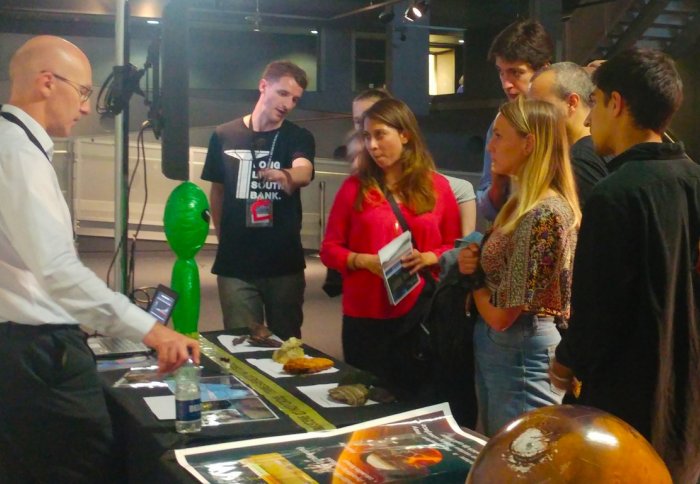
Earth scientists exhibit at Science Museum Lates and New Scientist Live
Contents
Publications
Conferences, Lectures and Seminars
Departmental Activities
Impact and Media
Outreach
Fieldwork
Publications
Alhammadi, A. M., AlRatrout, A., Singh, K., Bijeljic, B. and Blunt, M. J. (2017). In situ characterization of mixed-wettability in a reservoir rock at subsurface conditions. Sci. Reports (Nature Publ. Group). doi:10.1038/s41598-017-10992-w
Avdis, A., Candy, A. S., Hill, J., Kramer, S. C., Piggott, M. D. (2017). Efficient unstructured mesh generation for marine renewable energy applications. Renewable Energy. https://doi.org/10.1016/j.renene.2017.09.058
Boyce, A., Bastow, I. D., Rondenay, S., and Van der Hilst, R. D. (2017). From Relative to Absolute Teleseismic Travel Times: The Absolute Arrival?Time Recovery Method (AARM). Bulletin of the Seismological Society of America. 107(5): 2511–2520. doi: https://doi.org/10.1785/0120170021.
Childs, C., Holdsworth, R.W., Jackson, C.A-L., Manzocchi, T., Walsh, J.J. and Yielding, G. (2017). Introduction to the geometry and growth of normal faults. doi: 10.1144/SP439.24.
Claringbould, J.S., Bell, R.E., Jackson, C.A-L., Gawthorpe, R.L. and Odinsen, T. (2017). Pre-existing normal faults have limited control on the rift geometry of the northern North Sea. Earth and Planetary Science Letters. doi:10.1016/j.epsl.2017.07.014
Coleman, A.J., Jackson, C.A-L. and Duffy, O.B. (2017). Balancing sub- and supra-salt strain in salt-influenced rifts: Implications for extension estimates. Journal of Structural Geology. doi: 10.1016/j.jsg.2017.08.006.
Deng, C., Fossen, H., Gawthorpe, R.L., Rotevatn, A., Jackson, C.A-L. and FazliKhani, H. (2017). Influence of fault reactivation during multiphase rifting: The Oseberg area, northern North Sea rift. Marine and Petroleum Geology. doi: 10.1016/j.marpetgeo.2017.07.025.
Genge, M. J., Davies, B., Suttle, M. D., van Ginneken, M. and Tomkins, A. G. (2017). The mineralogy and petrology of I-type cosmic spherules: Implications for their sources, origins and identification in sedimentary rocks. Geochimica et Cosmochimica Acta. doi:10.1016/j.gca.2017.09.004
Genge M, J., Suttle M, D., and van Ginneken, M. (2017). Thermal shock fragmentation of Mg silicates within scoriaceous micrometeorites reveal hydrated asteroidal sources, Geology, 45 (10): 891-894. DOI: https://doi.org/10.1130/G39426.1
Hampson, G.J. and Premwichein, K. (2017). Sedimentologic character of ancient muddy subaqueous-deltaic clinoforms: Down Cliff Clay Member, Bridport Sand Formation, Wessex Basin, UK. Journal of Sedimentary Research, v. 87, p. 951-966. doi: 10.2110/jsr.2017.55
Jackson, C.A-L., Holford, S.P., Magee, C., Schofield, N. and Sun, Q., (2017). Subsurface expression of igneous systems and their impacts on petroleum systems. Interpretation. doi: 10.1190/INT-2017-0706-SPSEINTRO.1
Muxworthy, A. R. (2017). Considerations for latitudinal time-averaged-field palaeointensity analysis of the last five million years. Front. Earth Sci. doi: 10.3389/feart.2017.00079
Nagy, L., Williams, W., Muxworthy, A.R., Fabian, K., Almeida, T.P., Conbhuí, P.Ó. & Shcherbakov, V.P., 2017. Stability of equidimensional pseudo–single-domain magnetite over billion-year timescales, Proceedings of the National Academy of Sciences, 10.1073/pnas.1708344114.
Salimzadeh, S., Usui, T., Paluszny, A., Zimmerman, R. W. (2017). Finite element simulations of interactions between multiple hydraulic fractures in a poroelastic rock. Int. J. Rock Mech. Min. Sci., vol. 99, pp. 9-20. http://www.sciencedirect.com/science/article/pii/S1365160917303532
Suttle, M. D. and Genge, M. J., 2017. Diagenetically altered fossil micrometeorites suggest cosmic dust is common the geological record. Earth and Planetary Science Letters, 476, pp.132-142. doi:10.1016/j.epsl.2017.07.052
Zimmerman, R. W. (2017) Pore volume and porosity changes under uniaxial strain conditions. Transp. Porous Media, vol. 119(2), pp. 481-498. https://link.springer.com/article/10.1007%2Fs11242-017-0894-0
Conferences, Lectures and Seminars
Alex Whittaker and PhD students Sam Brooke, Alex Hughes, Jennifer Quye-Sawyer and Stephen Watkins presented at the BSG (British Society for Geomorphology) annual meeting in Hull (4–6 September). Jennifer won the Bernie Smith prize for the best postgraduate oral presentation.
The Annual Conference of the Remote Sensing & Photogrammetry Society (@RSPSoc) was held in the department (5–8 September), organised by Philippa Mason (convener), Jian Guo Liu, Sanjeev Gupta and Richard Ghail, and was a great success. The conference was well attended with delegates from 19 countries around the world; two from India only obtained their visa the night before the conference began and yet still managed to arrive in time to give their talks! The excellent technical programme included sessions on hazards & risk, LiDAR and Hyperspectral analysis, and double sessions on planetary geoscience and on InSAR exploitation, both of which included multiple talks from within the department.
The day to day smooth running of the conference was ensured by a fabulous team of our UG students (Avni Patel, Harry Lawrence, Ellie Bryant, Joss Knight, Harry Bushell, Chris Allison, Joe Fletcher, George Decaudevine, Loic D’Assier and Eliza Karlowski) in addition to Post-Docs Rob Barnes and Steve Banham, who also presented; thanks to all of them. Mark Sephton kindly opened the proceedings in 170 Queen’s Gate, over a glass of wine or two; the delegates all certainly seemed to enjoy the social events which included a boat trip on the Thames and the Annual Dinner in the Queen’s Tower Rooms.
During the conference, the UK Space Agency and Satellite Applications Catapult also held their Space Placements in Industry (SPIN) Annual Showcase in ESE. Students on this internship programme (‘SPINterns’), from across the UK, presented and discussed their work with company representatives and other potential SPINterns, and were treated to a virtual field trip on Mars, inside the DSI visualisation suite, led by Sanjeev.
Tina van de Flierdt, and PhD students Rachel Bertram and Patric Simoes Pereira attended the Past Antarctic Ice Sheet (PAIS) conference held in Trieste, Italy, in September. Tina gave a talk showing the behaviour of the East Antarctic ice sheet in the Late Pleistocene (work conducted with David Wilson), while Rachel and Patric both presented posters showing their PhD research. Rachel was awarded one of two student poster prizes.
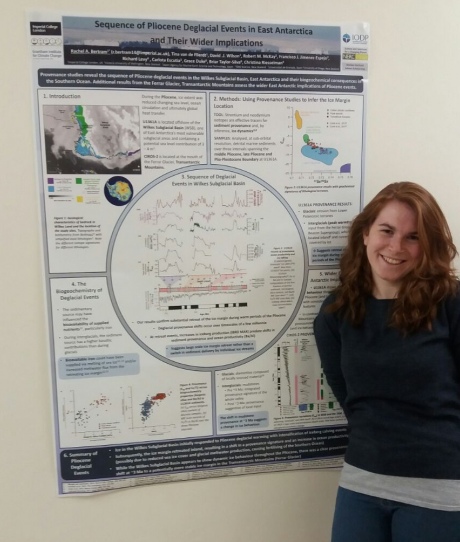
The Palaeobiology Research Group was well represented at this year’s annual meeting of the Society of Vertebrate Palaeontology and Comparative Anatomy (SVPCA), held in Birmingham (12–14 September). Phil Mannion presented on spatiotemporal biases and patterns in the fossil record of crocodiles, and PhD student Ale Chiarenza gave his first conference talk – using ecological niche modelling to shed light on dinosaur diversity in the lead-up to their extinction. Jonathan Rio also presented a poster, outlining his PhD project on using the fossil record of crocodiles to assess the extinction risk of living species.
Robin Thomas, a PhD student in the Rock Mechanics Group, attended the 3rd Advanced Training Course on CO2 Storage in Deep Geological Formations, in Barcelona, from13–14 September. The course was organised by the EC FP7 TRUST project, the IC participants in which are Adriana Paluszny and Robert Zimmerman.
Tom Phillips, Craig Magee, and Chris Jackson attended the IMAGinING RIFTING workshop in Pontresina, Swiss Alps (25–29 September). The workshop, which focused on the geodynamic, structural, and stratigraphic development of continental margins during plate stretching, included formal presentations, informal discussion, and 2 days in the field, looking at a fossil continental margin exposed in the Swiss Alps. Tom gave a keynote presentation, presenting results arising from his PhD research that has focused on the role of structural inheritance during continental extension.
Wren Montgomery gave a talk at the 9th Workshop on Infrared Microscopy and Spectroscopy with Accelerator Based Sources, WIRMS 2017 (25–28 September). Wren’s talk was titled "The effects of high pressure on organic molecules representative of natural organic matter types observed by synchrotron infrared spectroscopy." The workshop was hosted by Diamond Light Source, at Worchester College, Oxford.
Members of the LODE group - Jamie Wilkinson, Matt Loader, Matt Hodgkinson, Yannick Buret and PhD students Robert Sievwright and Emily Brugge attended the Geological Society's flagship Fermor Meeting at the Geological Society, London, (25–27 September). Entitled "Factory Earth" the meeting addressed the fundamental controls on metal transport and deposition in magmatic systems and addressed questions such as:
- * What role do sulfide melts play in metal transport?
* What are the key components of fertile magmas and how can they be identified?
* What role do volatiles and semi-metals play in transporting and depositing metals?
* How are ore metals concentrated during magmatic differentiation and transferred to the hydrothermal environment?
Jamie Wilkinson presented a plenary-keynote talk to kick the conference off entitled "Porphyry-type ore deposits: origins, fertility indicators and exploration targeting" which reviewed the origins of porphyry-type ore deposits and summarised the new tools being developed to identify key processes in their formation and for improving the efficiency of exploration. Matt Loader gave an invited talk on his PhD results on zircon geochemistry (recently published in Earth and Planetary Science Letters) and Matt Hodgkinson summarised ongoing work on the use of plagioclase chemistry as an exploration tool.
Overall, some great science was presented that stimulated lively discussion and debate. The bringing together of petrologists, volcanologists and economic geologists to consider processes of common interest proved to be highly effective - we hope to see much more of this kind of interaction in the NERC FAMOS Research Project that got underway in May.
Robert Zimmerman visited Northeastern University in Shenyang, China, where he delivered a short course entitled "Fundamentals of Rock Mechanics", and a research seminar entitled “Some Applications of Rock Failure and Fracture in Petroleum Engineering and Mining".
Departmental Activities
A mental health awareness team is now in place in the Department of Earth Science and Engineering. Visit the website here.
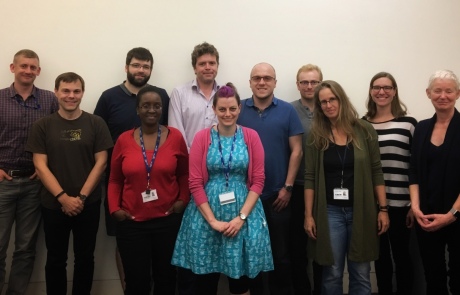
Grad Soc organised a great coffee morning to raise money for Macmillan Cancer Support raising just over £139.
On Sunday 17 September Chris Jackson, Sam Krevor, and former research fellow Susie Maidment, took part in the Descente London Duathlon Relay. Operating under the team name of ‘Pure Sexy Power Inc’, Sam (10 km run), Susie (44 km bike ride), and Chris (5 km run) finished in a time of 2 hours 35 minutes, finishing a respectable 14th out of 75 entrants. With a little more training, a top 10 finish awaits next year.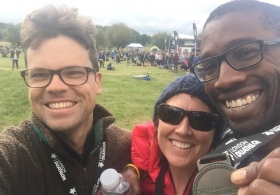
Impact and Media
PhD student Martin Suttle and Matt Genge’s research on fossil micrometeorites featured on the College website and several other online news websites including ITV, the Independent, FOX and the Daily Mail.
Mark Sutton featured in the Independent, commenting on new evidence for the oldest life on Earth.
PhD student Ale Chiarenza from the Palaeobiology Research Group was interviewed for an article in the Guardian this month. Ale discussed his research and painted a vivid picture of the landscapes he studies.
Outreach
On September 29, PhD student Jennifer Quye-Sawyer gave a talk at an outreach event for year 10-11 pupils in London schools, through the Outreach Postgraduate Ambassadors programme. Jennifer spoke about her research, and experience studying geology at university.

Adrian Muxworthy, Alex Whittaker, Craig Magee and Rebekah Moore attended New Scientist Live at the ExCel exhibition centre (28 September – 1 October), where they teamed up with the Geological Society of London to amaze people with the oldest rock on Earth, how water and syrup can be used to show why some volcanoes erupt explosively and others do not, and the pioneering use of geochemistry in biomedical research. The event was well attended by all age groups and good fun was had across the board.

Mark Sephton, Peter Gordon and Ruth Davey attended Science Museum Lates to share their search for evidence of life on Mars. Mars and Earth have had similar climates at times in their history; people came to find out how the climate of Mars has changed and learn about the geology of the Red Planet.

PhD student Jay Shah was interviewed for EGU’s GeoTalks blog series about the South Atlantic Geomagnetic Anomaly.
Martin Suttle co-wrote a blog article on cosmic dust in Antarctica for the Oxford University PhD DTP course.
Fieldwork
From 24–29 September, PhD students Chris Ogden, Al Boyce and Mitch Liddell carried out service fieldwork in Cyprus on the 5 TROODOS broadband experiment seismometers. The 6 months of new data will be used to understand more about the crust beneath Cyprus, and to help the Cypriot seismological survey with real-time hazard assessment.
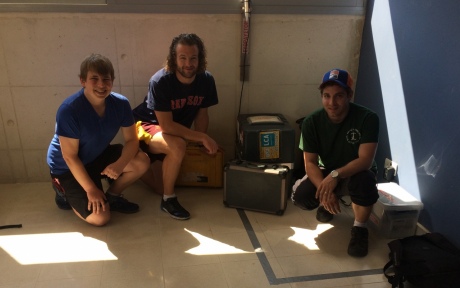
Article text (excluding photos or graphics) © Imperial College London.
Photos and graphics subject to third party copyright used with permission or © Imperial College London.
Reporter
Press Office
Communications and Public Affairs
- Email: press.office@imperial.ac.uk
